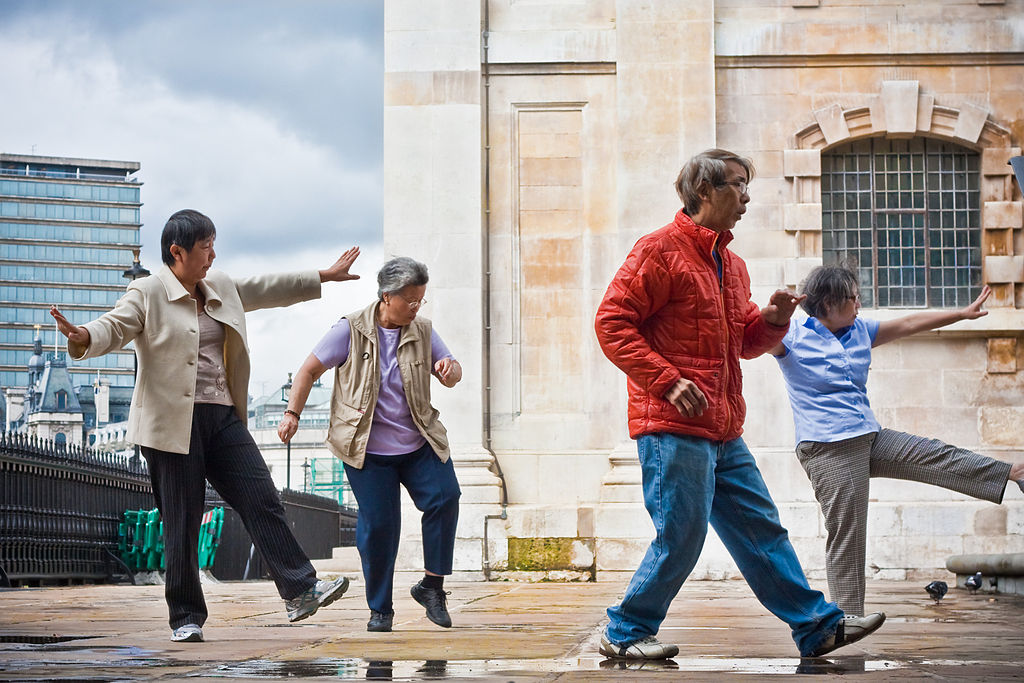 |
| Image by Paula Solloway |
We felt a little nervous as we had a lot of information and practise to get across in one day. We spent a couple of months reviewing research papers, discussing, writing, and editing lesson plans, and just thinking it through.
We finalised our plan to cover the most recent systematic reviews on the benefits of regular Tai Chi, recent UK guidelines on best practice with regard to physical activity - that also recommend regular Tai Chi practise, a brief history on the origins Tai Chi, and most importantly, plenty of practise.
We wanted to make sure that the attendees would get the chance to paraphrase Bruce Lee, to not just think about Tai Chi but feel it also.
 |
| Phil, Dr. Paul Lam, & Helen |
This short program proved perfect for our purposes as it has a good evidence base for its efficacy for improving health and well-being, and as a primary preventative exercise for falls prevention.
At the end of the day, feeling exhausted and elated at the same time, we gathered in the anonymous feedback forms from all the attendees. We felt a little more than blown away faced with the positive reviews.
We'll let the attendees words speak for themselves:
 |
| UK Physical Activity Guidelines 2019 |
What did you find most beneficial?
- "Good evidence base which is important for evidence-based practice. Practical workshop really good."
- "I would say that this course was not only useful for my patients but useful for myself too."
- "Well presented, friendly atmosphere created Highly enjoyable and worthwhile. Thanks."
- "Good passionate presenters; good amount of practical elements, thanks!"
- "Informative useful, well-paced, excellent."
- "Very useful techniques/ideas. Interesting new concepts."
- "Evidence-based - Engaging articulate hosts."
- "Very informative good instruction."
- "Enjoyable, learning a new experience. Anybody can do it."
- "Fantastic Knowledge very engaging teaching."
- "Good foundations for something bound to be more popular and relevant in the future of physiotherapy."
- "Link of evidence to practice - the scientific basis."
- "Examples that were given of the conditions or presentations that may benefit."
- "Practical element very enjoyable and good pace."
- "Useful techniques/approaches to use in practice and to identify individuals to refer on."
- "Lead by medically framed/evidence-based professionals and constantly related to MSK conditions and biopsychosocial model."
- "Clear concise instructions, good info on background/history.
- "Really enjoyed the practise and learning the sequences."
- "Practical and scientifically evidence-based."
- "Measured clear instruction."
- "Ideas for falls patients! The ways moves can be applied to complex needs patients."
 |
| Image by Kate Bamber Photography |
We would like to express our appreciation to all the attendees on the day who got into the spirit of things right from the start and remained enthused to the very end.
- "No."
- "Very thorough content."
- "You exceeded expectations!"
If you would like us to run a dedicated evidence based CPD workshop for you and your colleagues, or you would like to find out more about Dr. Paul Lam's Tai Chi for Health programmes please do get in touch.

T: 07528 959091
E: huntunwellbeing@gmail.com
We look forward to talking with you.
Helen & Philip





